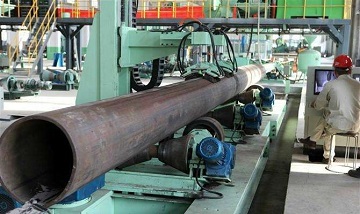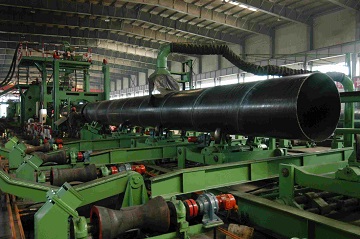Categories
- Pipe & Tube (18)
- Flange & Fitting (97)
- Fastener & Gasket (12)
- Valve & Pump (18)
- Base Material (11)
- Equipment (8)
- Application (30)
- Technical (110)
The ASTM A134 EFW steel pipe refers to electric-fusion-(arc)welded straight seam or spiral seam steel pipe NPS 16 and over in diameter, with wall thicknesses up to 3/4″ (19.00 mm), inclusive. Pipe having other dimensions may be furnished provided such pipe complies with all other requirements of ASTM A134/ A134M. EFW steel pipes manufactured in accordance with ASTM A134 are usually large-diameter pipes. They are generally provided for low- or intermediate-pressure piping applications.

The production of ASTM A134 steel pipe with a straight seam. It is made by a submerged arc welding (SAW) process, which is also an EFW process.
The electric-fusion welding is also known as electro-fusion welding. It is abbreviated as EFW. If the finished pipe has a straight seam, it is called straight-seam EFW pipe or longitudinally EFW pipe. If the finished pipe has a spiral seam, it is called spiral-welded EFW pipe.
The steel from which the EFW pipe is made shall conform to standard specifications ASTM A36/ 36M, ASTM A283/ A283M, ASTM A285/ A285M, ASTM A1011/ A1011M, ASTM A1018/ A1018M, or to other ASTM specifications for equally suitable weldable material, as specified. For marking purpose, the pipe grade of material shall be in compliance with the steel plate grade. When used for ASME Section III Class III piping applications, the EFW steel pipe conforming to ASTM A134/ ASME SA-134 shall be made from steel plates in accordance with ASTM A283/ ASME SA-283 or ASTM A285/ ASME SA-285.

The fabrication of spiral-welded steel pipes conforming to ASTM A134.
In an EFW process for the manufacture of steel pipes conforming to ASTM A134, the arc generated between the steel plates and the consumable electrode (filler metal) provides sufficient heat to melt the filler metal. The melted electrode is then filled into the welding area and forms a longitudinal or spiral seam. The electric-fusion welding (EFW) in manufacturing steel pipes is also known as submerged arc welding (SAW). The longitudinal edges of the steel shall be shaped to give the most satisfactory results by the particular welding process employed. The steel shall then be properly formed and may be tacked preparatory to welding. Automatic welding machines shall be applied to obtain uniform width and height for the entire length of the pipe. All longitudinal seams, spiral seams, and shop girth seams shall be butt-welded. The welding procedure shall be qualified in accordance with the American Welding Society Standard Qualification Procedure or ASME Section IX of the Boiler and Pressure Vessel Code.
All testing and inspection shall be performed prior to shipment. The inspection and testing for ASTM A134 EFW steel pipes include tensile tests and chemical analysis on the steel plates. Ultrasonic tests shall be conducted on the steel plates before welding to ensure the soundness of raw material. X-ray inspection shall be conducted during/after the welding process. Tension tests shall be performed on the weld-test specimens. Its tensile strength shall be no less than 95% of the specified minimum strength of the steel. Each length of pipe shall be tested to a certain hydrostatic pressure for at least 5 seconds.
